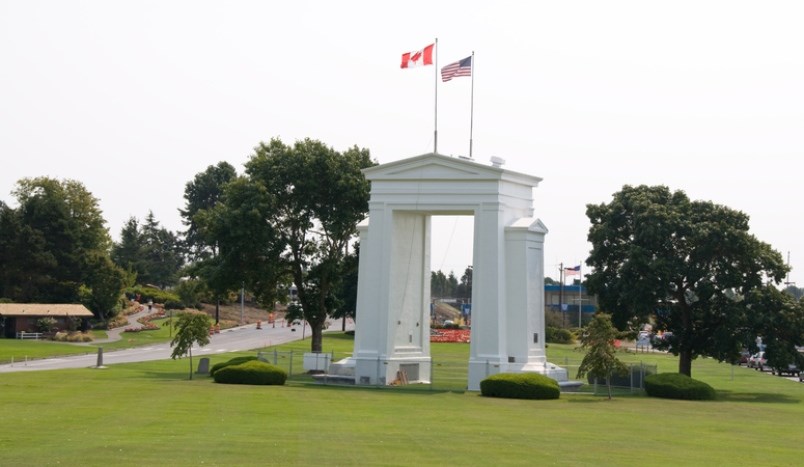Increasing numbers of travellers are entering Canada from the country with the world’s worst COVID-19 infection rate – the United States.
Canada Border Services Agency (CBSA) numbers show while the volume of people heading north is far below what it was a year ago, that volume has steadily increased month-over-month since the March pandemic lockdown started.
As the pandemic picked up force in the March 23-29 period, 99,096 people other than truck drivers entered by land crossings. Some 2,446 arrived from the U.S. by air. Passenger rail had dropped to nothing and remains that way.
The next week, 46,360 arrived by land and 992 by air. In the following weeks, land traveller numbers continued to fall.
The number of land travellers hit a low of 36,600 in the week of April 12 and then began rising incrementally by several thousand each week.
Johns Hopkins reported April 28 that the U.S. passed one million confirmed cases of the virus. A month later, university data showed the virus had killed 100,000 in the country.
The numbers of people entering from the U.S. by land hit 70,882 for the last week in June, three weeks after Johns Hopkins had announced the U.S. had passed two million cases. Some 10,550 entered by air.
The numbers did begin to surge after Ottawa announced in early June limited exemptions for family reunifications.
For the week ending July 27, 68,895 travellers entered Canada by land from the U.S. For flights coming from the U.S., 38,741 people entered the week ending March 29. At the end of the following week, that number had plummeted to 11,383. And, it continued to fall, hitting 3,189 in the week ending May 3.
Then, numbers began to grow, even as B.C. Health Minister Adrian Dix June 25 was alluding to the need to keep the border closed.
Those entering Canada must self-quarantine for 14 days and provide contact information to a border officer.
Health Canada and Public Health Agency of Canada (PHAC) spokesman Geoffroy Legault-Thivierge said strict provisions remain in place at the border for ensuring compliance with rules for entering Canada.
“Our priority is to protect the health and safety of Canadians. Current border restrictions remain in place,” Legault-Thivierge said. “The government of Canada will take a cautious approach to reducing measures related to international travel, including travel across the Canada-United States border.”
Ottawa introduced a ban on discretionary travel in March, extending it each month since.
"Canada and the United States have agreed to extend the current border measures by one month until August 21, and we're going to keep working closely with our American neighbours to keep people safe on both sides of the border,” Prime Minister Justin Trudeau said July 16.
Trudeau’s office did not respond to a request for comment on the growing entry numbers.
As of July 30, the United States has had 4.46 million reported cases and 151,451 deaths, Johns Hopkins University statistics show.
Canada has had 117,477 cases and 8,965 deaths as of July 30, the university said. PHAC puts those figures at 115,470 cases and 8,917 deaths as of July 29.
Legault-Thivierge said those entering by air or by land must provide name, date of birth, quarantine or isolation address and telephone number information and are checked on regularly for compliance.
“Several categories of people are exempted from the quarantine requirement upon entry into Canada because they provide essential services. The exemptions apply only to those who have no symptoms of COVID-19,” Legault-Thivierge said.
He said from March 25 to May 4, screening officers called all travellers displaying symptoms of COVID-19 and a random sample of non-exempt travellers without symptoms to verify compliance with quarantine or isolation requirements.
“As of July 26, a total of 222,783 non-exempt travellers received verification calls, out of the 433,275 travellers that have been subject to quarantine or isolation requirements since March 25, 2020,” he said.
For the week ending July 27, 14,715 travellers entered Canada from the U.S.
Travellers are asked questions about their health and symptoms and about their ability to meet the conditions outlined in the Mandatory Isolation Order to isolate or quarantine in an appropriate accommodation.
“They must also acknowledge that they are required, under the Quarantine Act, to isolate or quarantine for a 14-day period that begins on the day on which they enter Canada,” Legault-Thivierge.
Any easing of restrictions will be based on science and an assessment of domestic and international public health measures, he said.
Recently, the issue of people entering from the U.S. purportedly heading for Alaska became a concern.
As of July 31, strict conditions were put in place for such travel.
Such travellers can only enter at five designated entries in Saskatchewan, Alberta and B.C. and allowed a reasonable period to reach Alaska.
They will be limited to travel within Canada using the most direct route from entering Canada to entering Alaska while avoiding all national parks, leisure sites and tourism activities. They will be required to report to a CBSA officer before leaving.
Such travellers will be issued a rear-view mirror tag making it clear that the travellers are transiting and include the date they must depart Canada.
“The back of the tag will remind travellers to comply with all conditions imposed upon entry and the Quarantine and Emergencies Acts and a list of public health and safety measures to follow,” the CBSA said.
@jhainswo




